The makings of Laughter Yoga
In March 1995, Indian physician Dr Madan Kataria decided to write an article called ‘Laughter – The Best Medicine’ for a medical journal. Through his research he discovered a large number of modern scientific studies that described in great length the many proven benefits of laughter on the human mind and body. In particular, Dr Kataria was impressed by Norman Cousins’ book Anatomy of an Illness and the research work by immunologist Dr Lee Berk from Loma Linda University in California.
Profoundly inspired and being a man of action rather than an academic, Dr Kataria immediately decided to field-test the impact of laughter on himself and others.
At 7am on 13 March 1995, Dr Kataria and his wife Madhuri Kataria entered their local public park and persuaded 4 people to join in the very first ‘laughter club’. The small group stood in a circle, exchanging jokes. They enjoyed themselves — and bystanders also were amused.
Daily, they met and numbers grew to more than 50 participants within days.
After 2 weeks, they hit a snag: the stock of good jokes and stories ran out; hurtful, negative and naughty jokes started to emerge.
What could be done to overcome participants being offended or embarrassed?
In reviewing his research, Dr Kataria fond the breakthrough answer: our bodies cannot differentiate between acted and genuine laughter. Both produced the same ‘happy chemistry’.
The next morning he explained this to the group and asked them to try something new: they would laugh without jokes. He asked everyone to laugh with him for one minute. Amid skepticism they agreed to try…
The results were amazing. The group acted out laughter. After a moment, a few people burst into real laughter at their ‘silliness’. Soon the group was laughing like never before, hearty laughter lasting for almost 10 minutes.
From this, Dr Kataria went on to develop a range of laughter exercises, tapping into role-play and childlike playfulness.
As yoga practitioners, Dr Kataria and his wife saw the similarities between laughter and deep breathing techniques and incorporated elements of pranayama.
And so Laughter Yoga came into being, combining yogic deep breathing, stretching, laughter exercises and cultivated childlike playfulness that the world has grown to love.

